2022 Canyon Strive CFR Bike
(discontinued)
| Where To Buy | |||
|---|---|---|---|
Free shipping on orders over $50 (continental U.S. only).
International shipping available. Some exclusions apply. |
|||
Free shipping on orders over $50 (continental U.S. only).
International shipping available. Some exclusions apply. |
|||

When Canyon launched the current generation of the Strive in 2019, misgivings regarding the conservative geo somewhat overshadowed the ingenious “ShapeShifter” and other qualities of the bike. Online expert opinion notwithstanding, that bike did go on to win the EWS overall under Jack Moir, albeit with some tweaks in the form of longer forks and a taller lower headset cup to slacken the head angle. For 2022, Canyon went back to the drawing board to develop an entirely new Strive, which looks a lot like its predecessor but is different in nearly every aspect. We’ve spent two fun days in Finale Ligure aboard the new rig, and we’re here to tell you all about it – keep reading to learn more (or click "play" in the video window below if you prefer to get the lowdown that way)!
2022 Canyon Strive Highlights
- CFR (Canyon Factory Racing) frame construction (“category 4” rated)
- Shapeshifter
- Reach adjust head tube inserts (+/- 5mm)
- Replaceable ISCG tabs
- Threaded BB
- Max chainring size: 34T
- Double sealed pivot bearings
- Silent frame protection
- Foam-lined internal cable routing, removable cable ports
- Universal derailleur hanger
- 2-bolt extra frame storage mount
- Frame fits 750 ml bottle (size M and above)
- MSRP: CFR: 6299 EUR/$7299 USD // CFR Underdog 4999 EUR (the Underdog model will come to the US only in 2023)
Initial Impressions
When Canyon developed the 2019 Strive, they did so with certain constraints, most notable of which the absence of a 29-inch version of the Spectral at the time – that bike had just launched with 27.5-inch wheels only. Whilst the Strive was billed as a race bike, certain design choices were also dictated by this hole in the Spectral range, and so the 2019 Strive was asked to pick up the mantle and serve as a do-it-all, big-wheeled all-rounder. Today, the Spectral range has grown considerably, which left the Canyon engineers free to focus the new, 2022 Strive on its main task: winning enduro races.

Well, how do you win enduro races? Or perhaps we should say, how do you avoid LOSING enduro races? Winning is reserved for the elite few, and as we’ve seen time and time again, winning can be done aboard all sorts of weird and wonderful machines. Jack Moir dominating the EWS field lately with what so many deemed “outdated” geo is a good case in point, and we’ve also seen many racers sizing down when internet armchair quarterbacks keep calling for longer and longer bikes. The point we’re trying to make is that there is only so much you can do with the bike, getting to the very top step of the podium will always require supernatural rider abilities behind the bars. However, as a bike manufacturer you can still do A LOT to help your racer save time and energy, and that is exactly what drove the design choices behind the new Strive.


29-inch wheels only. No mullets here. In discussing this choice with multiple DH World Champ Fabien Barel, who has been heavily involved in all the R&D and testing of Canyon’s gravity range for the past 10 years in addition to also running the actual race teams, we were told that the big wheel was chosen because of its superior traction and ability to carry speed in flatter sections of trail. It also helps reduce rider fatigue at the end of a stage, which is equally crucial in getting to the finish line as fast as possible – and in one piece. Canyon’s testing showed that the time/energy advantage of the 29-inch wheel is so significant that it far outweighs any maneuverability advantage of a say a mullet configuration. Even the shortest racers out there will largely prefer to deal with the occasional rear wheel slap on the butt to unlock that extra rolling speed. The DH teams are all moving to high-pivot mullets you say, but DH is a different beast altogether. The fatigue factor is on another level in enduro, and the tracks often feature speed-sapping traverses or even punchy little climbs mid-stage to really send the rider into the hurt locker.


Fabien Barel also shared his insights regarding the Strive’s rather unique “ShapeShifter” technology that he has been instrumental in developing. When Fabien made the move from World Cup DH to the Enduro World Series, he found it hard to accept having to make compromises regarding a bike’s downhill abilities in order to be more efficient on flatter trails or on climbs. Wanting the best of both worlds, the ShapeShifter concept was born and has subsequently been refined taking into account 10 years of racing and riding around the world. The ShapeShifter is not a lock out, nor is it to be thought of as merely a climb switch – it does more than that. As its name implies, it actually changes the “shape” of the bike by shortening rear wheel travel, raising the BB, and steepening both the head angle and the seat tube angle.

Although the system does not adjust the shock itself at all, it changes the leverage and anti-squat ratios between the two modes which also translates to a reduction in pedal-induced bobbing under power. ShapeShifter is based around a small piston that compresses or extends as you switch between Pedal and Shred mode, which changes the position of the shock pivot point on the rocker arm (the extra lever needed for the ShapeShifter has been combined with the dropper post lever for a clean and functional cockpit).


The overall leverage ratio is fairly progressive and the bike will play nice with both a coil and an air shock. The anti-squat number is now much higher in Pedal mode compared to the previous generation Strive, with a curve shape that provides a lot of pedaling support in the early part of the travel while dropping off significantly past the sag point. Remember how the ShapeShifter is meant to be more than just a climbing crutch? This anti-squat curve is a prime example of that – the bike is meant to be ridden hard also in Pedal mode, and as such, Canyon wanted to minimize pedal kickback deep in the travel also in the shorter travel setting.

It wouldn’t be a new 2022 bike if it wasn’t also longer and slacker, right? Canyon won’t be accused of merely following a trend for the sake of it however, as the previous bike was indeed highly conservative in the geometry department and the race team had some requirements that also needed to be addressed. The result is a bike that has grown considerably in reach and wheelbase, with a 63-degree head angle in Shred mode that would not look out of place on a DH or freeride bike. The chainstays are still a fairly short 435 millimeters in length, and that measurement is the same across the whole size spectrum. The short stays match up with a longer front-center and an imposing wheelbase, which should help the rider feel comfortable in an aggressive, forward-biased riding position, while maintaining enough nimbleness out back to deal with tighter trails and transitions. Note that the Strive features an oval head tube which allows for 5 millimeters of reach adjust in either direction from the “stock” setting, to allow riders to really dial in their personal sweet spot. The seat tube has also gotten a lot steeper here compared to the previous generation of the bike, which is of course meant to make those grueling liaisons a bit easier to live with.

Frame and Build Kits
With the decision taken to make the new Strive primarily a race bike, Canyon also opted for producing it with a CFR frame only (Canyon Factory Racing version, a high-end frame construction that saves weight but also costs more to make). All the tubes have been given new shapes for the 2022 bike, and the frame has gained 25% of stiffness in the front triangle compared to the previous generation.

The new frame also weighs 300 grams more, due to the extra carbon used to meet the stiffness requirements. That does not exactly mean that it’s a heavy frame, quite the contrary – it only weighs 100 grams more than the rather svelte Spectral 29 frame, for example. The internal cable routing is not guided, so extra foam tubes need to be added to the cables where they pass through the frame. There is a large “skidplate” to protect the BB and downtube, as well as a full-length chainstay guard with the now ubiquitous ridges to help silent any unwanted chainslap noises. SRAM’s Universal Derailleur Hanger (UDH) means finding a replacement for this crucial component should be increasingly easy and convenient when you need it.








The new Strive will only be offered with two build levels, the top CFR spec at 6299 EUR or $7299 USD and the CFR Underdog spec at 4999 EUR (the Underdog model will come to the US only in 2023). FOX 38/Float X2 suspension, Shimano shifting and braking, with Maxxis tires and Canyon’s own finishing kit including cockpit and dropper post. Both bikes are available in two different colors, the silver/black that we tested and a grey/orange version. There is no frame-only option to purchase.

Riding the New Canyon Strive
Canyon whisked us away for two days of riding in Finale Ligure, which as the spiritual home of the EWS and one of the most popular enduro riding zones in Europe is of course the perfect testing ground for any bike with enduro racing aspirations. Canyon’s event team was on hand to help set up the bikes and provide technical support during the testing, and local shuttles were provided to ensure we would be able to sample a full selection of trails and eat enough vert to really form a solid first opinion of the performance of the new bike.

A few words on the new geo. These bikes are long. Very long. The previous Large had a reach of 460 mm, whereas the new Medium is 480 mm. In essence, each size has actually grown by TWO sizes when comparing the old and the new bike. The seat tubes are short however, so all this really means is that you can pick a reach number that you are comfortable with and go ride your bike – although the size S now starts at 455 mm of reach which together with the 29-inch wheels probably make it less suited for the shortest riders out there. Still, we probably don’t need to debate any “outdated” geo in the comments section anymore. Our tester settled on a M, at 1m84 (6’0”) he is comfortable anywhere between 470-490 mm reach in general. You have an extra +/- 5 mm of reach adjust from the “stock” number thanks to the oval headtube inserts, so you’ll be able to fine tune the fit as well. We left ours in the middle setting for this test which was a good choice given the diversity of trails on hand – ranging from tight and twisty to flat out fast and rocky.


Setting up the new Strive was fairly easy. We’re already well familiar with the FOX 38 of course, so finding the right fork settings didn’t take us long. We settled on 30% sag in the rear, which left only the ShapeShifter to dial in. Set the ShapeShifter pressure to equal to or 10-20 psi more than in the shock, and the system works great. In our case, about 200 psi (set with the ShapeShifter in trail mode).

There’s a fair amount of damping available in both the fork and the shock, so we found ourselves backing off both compression and rebound settings as the testing progressed. Starting off with fairly conservative rebound speed provided a sure-footed ride but also left the bike lacking a bit of “pop”. A few clicks less on compression and rebound saw it come alive, and we found a happy place for the kind of riding we did here in Finale. Lots of fast, steep and rocky trails with no shortage of last-second surprises to keep us on our feet. This type of terrain really helped hammer home the importance of a bike that inspires confidence and that will save your ass when you overcook a rock garden on tired legs at the end of a racing stage. Incidentally, these handling characteristics also proved invaluable for this non-racing tester…who got in over his head more than once! Finale is no joke, especially when you’re riding blind on unknown trails a lot of the time.


One of the classic trails in Finale is called Rollercoaster. To access the start of the trail from the shuttle drop-off point you have a 10-minute climb to deal with, including a fairly steep bit with some rocks and roots added for extra fun. We found the Strive easy to live with on climbs, there is a certain amount of pedal bob present but it never feels sluggish, and the steep seat tube angle is a boon when headed up the hill. The ShapeShifter does not provide any kind of lockout function but you can feel it support you with a higher BB and less sag.

Once you crest the climb, the trail starts out with a fast and sometimes rough top section, which is perfectly suited to the new Strive in Shred mode. Stable at speed and with plenty of reserves to deal with bigger hits and harsh landings, the bike is surefooted and confidence inspiring as you point and shoot between the rocks, roots, and trees.

The second part of the trail is flatter, with plenty of ups and downs linked together with fun, swooping turns – this section is of course the reason that the trail is named Rollercoaster. This is where the ShapeShifter feature really comes into its own. By raising the rear end of the bike and shortening the travel in Pedal mode, it helps to place the rider in a more central/forward position and it also helps the bike pump and carry speed. It does change the balance of the bike’s suspension, with the long and plush fork suddenly finding itself mated to a livelier and snappier rear end, but it’s easy enough to adjust your body language to this new reality and the benefits outweigh the inconvenience on the right type of trail. When things get steep again, a simple click of the lever puts you back in Shred mode. Fabien Barel confirmed that Jack Moir uses the ShapeShifter “pretty much on every stage”, and after these two days of riding we can clearly see the benefit in a racing situation. If you only own one bike, it also makes for a great solution to expand the comfort zone and the fun factor of your single-steed quiver.

That leads us neatly to the final question: who is this bike for? It was designed for enduro racing, so that question is pretty easy to answer. Should you consider it if you don’t race? If you ride demanding terrain and you’re looking for a bike that provides plenty of confidence yet retains a lively enough feel to be fun to ride pretty much anywhere – further aided in this aspect by the innovative and effective ShapeShifter – the new Strive would also be a great choice. Hunting for KOMs on your gnarly local trails? Probably one of the best tools for the job! If you have freeride aspirations, the lack of a mullet option might be an issue, and that might also factor into your decision making if you are on the shorter side.
Kit Report
A few notes on how the components of our Strive CFR performed during this short test:
Suspension
The FOX 38 is a very stiff and plush fork, incredibly well suited to aggressive riding in heavy terrain. It’s both supportive and forgiving, not all that far off the performance of a true DH fork without feeling sluggish. It won’t give up full travel all that easily, but that doesn’t mean it feels harsh. The Float X2 out back is a great match for this fork, and we found it mostly got on with its job without complaints. A couple of square hits left it feeling like it choked a bit once or twice, but that may just as well have been the result of very poor line choice.

Shifting
Shimano’s latest 12-speed groups are firm favorites of ours, and the XTR transmission specced on this Strive CFR was as spectacular as ever. Crisp shifts even under load, nary a dropped gear and the ability to shift multiple gears in both directions as the cherry on the cake.

Braking
We love Shimano’s XT/XTR brakes almost as much as we love their 12-speed transmissions. Powerful yet very easy to modulate, they offer dependable stopping power in every situation and a very intuitive feel at the levers. The only fly in the ointment is the wandering bite point issue – an unfortunate tendency to have the bite point change position after rattling through a rockgarden or pushing hard through a turn. The issue is never really detrimental to performance, it can just be a bit unsettling until you get used to it. We had it happen to the rear brake on this bike a couple of times during the two days of riding, but all in all the issue is under control.

Tires and Wheels
We were initially somewhat disheartened to find Maxxis EXO+ tires fitted, but we were about to be pleasantly surprised. Maxxis claims to have improved puncture resistance by up to 20% on the 2022 version of their EXO+ casings, and our experience at this press camps seems to back up this claim. Despite the very rocky tracks the group experienced very few if any flats. Definitely a surprise given the nature of the tracks and the enthusiasm of the riders. As for the tread patterns chosen, the Assegai/DHR II combo is tried and trusted the world over in all kinds of conditions, definitely a solid pick for the stock builds here. DT Swiss EX511 rims are an equally solid choice, but we’d have loved to see a faster engaging hub specced on this race bike.

Finishing Kit
Canyon makes its own range of cockpit parts and dropper posts under the “G5” name (which is a reference to Canyon’s internal testing regimen, the toughest of which is the Category 5 which certifies the parts as suitable for freeride and DH use). We were pleased with the angles and the performance of the cockpit – note that the grips are on the thinner side but if that’s an issue for you it can be solved with 30 bucks fairly easily. The dropper post went up and down when we wanted it to, and it did so relatively quickly and smoothly. As mentioned previously, we like the integration of the dropper post and the ShapeShifter levers, which manages to find a good spot for both of them. Only the “release” lever of the ShapeShifter sits a little bit too far from your fingers, but it’s workable on the trail.

What’s The Bottom Line?
It’s always had to please everybody, so sometimes you’re better off not even trying. Canyon took direct aim at the racing market with the new Strive, making it longer, slacker, and more stable at speed. Thanks to the clever ShapeShifter system, they’ve also created a two-bikes-in-one solution that can be more effective than a traditional big-hitting enduro bike on mellower trails and on climbs. Paradoxically, this race-oriented beast will also serve non-racers well, in particular those looking to conquer rough trails at speed. The bike is very long and rolls on 29-inch wheels exclusively, so it may not be ideal for the shortest riders out there, but everybody else should be able to find a suitable match in the wide range of sizes available.
More information at www.canyon.com.
About The Reviewer
Johan Hjord - Age: 49 // Years Riding MTB: 17 // Weight: 190-pounds (87-kg) // Height: 6'0" (1.84m)
Johan loves bikes, which strangely doesn’t make him any better at riding them. After many years spent practicing falling off cliffs with his snowboard, he took up mountain biking in 2005. Ever since, he’s mostly been riding bikes with too much suspension travel to cover up his many flaws as a rider. His 200-pound body weight coupled with unique skill for poor line choice and clumsy landings make him an expert on durability - if parts survive Johan, they’re pretty much okay for anybody. Johan rides flat pedals with a riding style that he describes as "none" (when in actuality he rips!). Having found most trail features to be not to his liking, Johan uses much of his spare time building his own. Johan’s other accomplishments include surviving this far and helping keep the Vital Media Machine’s stoke dial firmly on 11.
Product Photos by Johan Hjord // Action Photos by Boris Beyer/Canyon
Specifications
Rear: Maxxis Minion DHR II, 3C MaxxTerra, EXO+, 29" x 2.4"
Drop: 150mm (SM), 170mm (MD/LG), 200mm (XL)
• Reach adjustable by flipping headset cups
• Internal cable routing with foam housing sleeves and removable cable ports
• SRAM UDH (Universal Derailleur Hanger)
• Includes tool case, torque wrench set, shock pump, and assembly paste
• Frame weight: 2.4kg
• UK price: 5999 GBP
• European price: 6299 EUR
Shapeshifter technology changes rear shock orientation via gas spring (modes selected via handlebar-mounted remote):
• Pedal mode: steeper angles, higher bottom bracket, firmer ride feel for more efficient climbing, shorter wheelbase, 140mm rear travel
• Shred mode: slacker angles, lower bottom bracket and center of gravity, softer ride feel for descending, longer wheelbase, 160mm rear travel
| Where To Buy | |||
|---|---|---|---|
Free shipping on orders over $50 (continental U.S. only).
International shipping available. Some exclusions apply. |
|||
Free shipping on orders over $50 (continental U.S. only).
International shipping available. Some exclusions apply. |
|||


















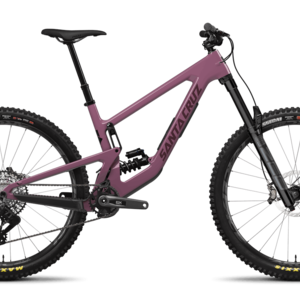
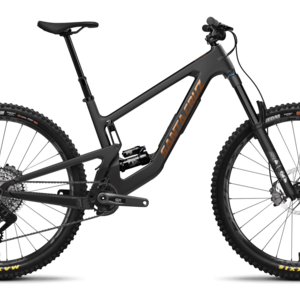

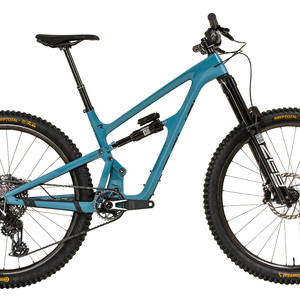
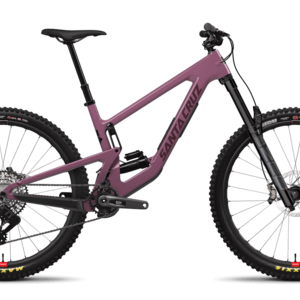

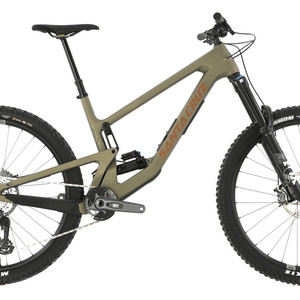
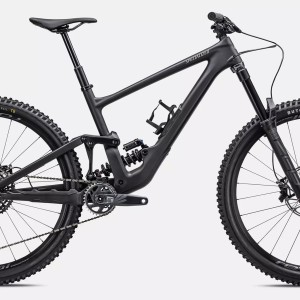

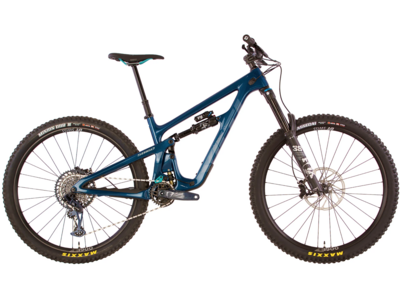




6 comments
Post a reply to: Fast and Focused: All-New Canyon Strive 2022 Ridden